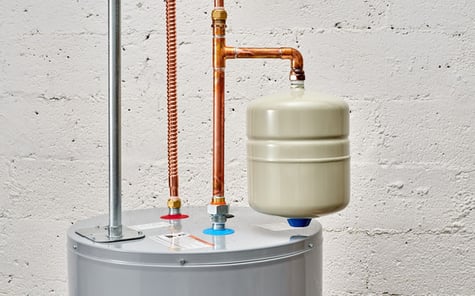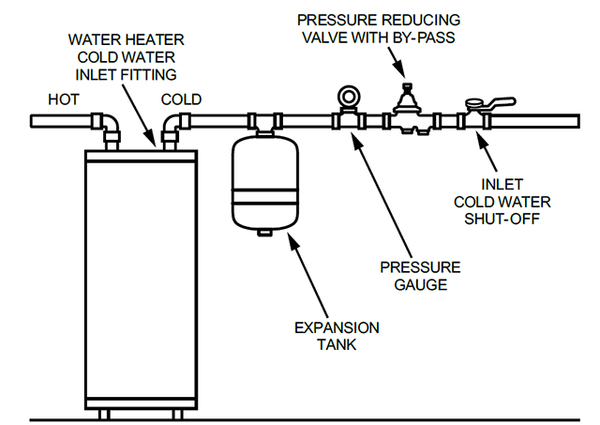What is an Expansion Tank?
Are you interested in purchasing an expansion tank and not sure whether or not to take the plunge? Or do you already have one but are unsure what exactly having an expansion tank contributes to your home or business? You’re in luck and have come to the right place!
We here at Monkey Wrench Plumbing have worked with thousands of clients over the past six years and have been dedicated to helping them with any plumbing questions they may have.
In this article, we are going to explore:
- What an expansion tank is and how it works
- Potential costs you will face
- The benefits and drawbacks of having an expansion tank installed as part of your water heater.
We want to help you understand expansion tanks and how it protects your water heater, pipes, and plumbing system.
What is an expansion tank?
An expansion tank is another small tank that is attached to the water supply pipe of the water heater that helps alleviate pressure. This pressure is caused by thermal expansion (or the process of water expanding due to it being heated) that happens when water is being heated by your water heater. If the water pressure gets too high, it can damage valves in plumbing fixtures, supply pipes, and the water heater itself.
This extra tank is also a safety feature for your water heater, as, without an expansion tank, it can cause excessive scale or residue buildup, which leads to blockage problems with your plumbing system.

There are also three different types of expansion tanks:
- Reverse osmosis: Reverse osmosis expansion tanks are meant to provide clean water storage in the water treatment system.
- Potable: Potable expansion tanks are used for your standard water heater.
- Hydronic: hydronic expansion tanks are used for space heating, floor heating, heated walls, etc.
Now that we know what an expansion tank is, let’s dive into how it works for both your tankless and conventional water heaters.
How does it work?
Well, within an expansion tank, there is a pressurized air bladder that absorbs the additional water by expanding and contracting. As the water becomes hotter, it expands and increases the pressure within the tank and plumbing system. However, instead of allowing the pressure to build, the excess water enters the expansion tank.
In short, an expansion tank only contains overflowing water and does not store water on a permanent basis. Also, the expansion tank must be pressurized to match the water pressure in the home.

For example, when you boil a pot of water and you have the lid over it, the water begins to condense on the inside of the lid, forming little droplets of water, right? The same concept happens inside your plumbing system. Inside your pipes, that extra pressure is formed and has to go somewhere, that’s where the expansion tank comes in. The device absorbs that extra pressure created from heating the water in your home or business so that it doesn’t just stay in your plumbing system and start putting a lot of strain on your pipes.
How much does an expansion tank cost?
Having your average expansion tank installed will cost you anywhere between $600 to $850. However, due to the amount of labor required and the parts needed to install the tank, you should definitely anticipate the price to go up. Now, we’re not saying it’s going to cost you thousands of dollars but will be an added expense.
Now that we’ve touched on the basics surrounding an expansion tank, you must now be wondering, what are the benefits and drawbacks of having one?
What are the benefits and drawbacks?
There are benefits and drawbacks to having an expansion tank in terms of value to your home and your plumbing system.
Benefits
- Safety
Having an expansion tank installed will relieve the pressure from thermal expansion and ultimately protect your water heater from damage. Not having an expansion tank can damage your plumbing system. - City Code
Having an expansion tank is considered part of Los Angeles County city code. So if you have one, not only are you protecting your water heater, but you are also up-to-code in the city.
Drawbacks
- Costs
Since it's not included with a water heater, this will be an add-on that you'll want to factor into the budget.
Bottom Line
There you have it! We’ve talked about what an expansion tank is, how it works, the costs, and some benefits and drawbacks involved with having one installed.
We here at Monkey Wrench Plumbing have worked with thousands of clients and have helped them through making tough decisions. Ultimately it’s up to you to decide what is going to be best for you and your home/business.
If you are still deciding on which water heater works best for you, read this comparison article that explains the difference between a conventional and tankless water heater. It guides you on the right path to selecting the water heater that is right for you. If you have any further questions about expansion tanks or are experiencing any other issues with your plumbing, call us at (310) 853-8690 or request an appointment by filling out the form below.



